
Crichtonsaurus is a genus of herbivorous ankylosaurid dinosaur that lived during the Late Cretaceous in what is now China. It was named after Michael Crichton, the author of the dinosaur novel Jurassic Park. A sister taxon was discovered, C. benxiensis, which is now identified as a separate genus.
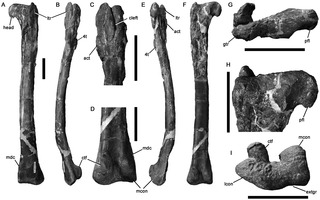
Timimus is a genus of small coelurosaurian theropod dinosaur from the Early Cretaceous of Australia. It was originally identified as an ornithomimosaur, but now it is thought to be a different kind of theropod, possibly a tyrannosauroid.

Anabisetia is a genus of ornithopod dinosaur from the Late Cretaceous Period of Patagonia, South America. It was a small bipedal herbivore, around 2 metres long.
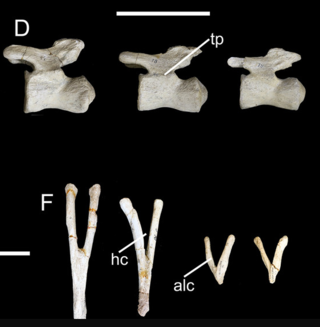
Baurutitan is a genus of sauropod dinosaur that lived during the Late Cretaceous in what is now Brazil. The type species, Baurutitan britoi, was described in 2005 by Kellner and colleagues, although the fossil remains had already been discovered in 1957. Baurutitan is classified as a lithostrotian titanosaur, and is distinguished from related genera based on its distinctive caudal vertebrae. This South American dinosaur was found in the Serra da Galga Formation near Uberaba, in the Brazilian state of Minas Gerais.
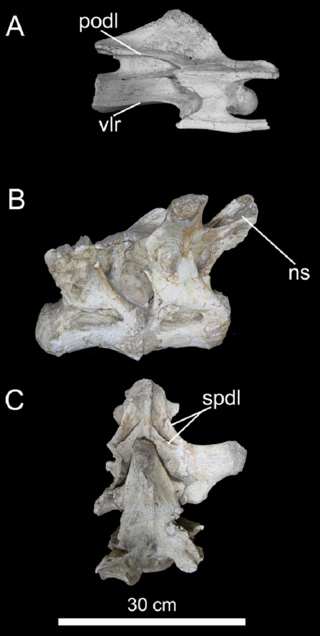
Trigonosaurus, is a genus of saltasaurid dinosaurs from the Maastrichtian Serra da Galga Formation of Brazil. The type species, Trigonosaurus pricei, was first described by Campos, Kellner, Bertini, and Santucci in 2005. It was based on two specimens, both consisting mainly of vertebrae. The two specimens were originally believed to have come from the same individual. However, one specimen was described as the holotype of Caieiria in 2022, while the holotype may have instead come from Baurutitan. Before its description, it was known as the "Peirópolis titanosaur", after the place it was found.

Nedcolbertia is a genus of theropod dinosaur from the Early Cretaceous Period of North America.

Cretornis is a pterosaur genus from the late Cretaceous period of what is now the Jizera Formation in the Czech Republic, dating to about 92 million years ago. It only contains a single species, Cretornis hlavaci.
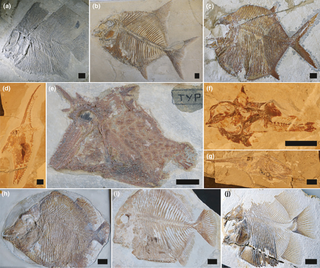
Pycnodontiformes is an extinct order of primarily marine bony fish. The group first appeared during the Late Triassic and disappeared during the Eocene. The group has been found in rock formations in Africa, Asia, Europe, North and South America. They were small to middle-sized fish, generally with laterally-compressed deep bodies, some with almost circular outlines, adapted for manuverability in reef-like environments, though the group was morphologically diverse. Most, but not all members of the groups had jaws with round and flattened teeth, well adapted to crush food items (durophagy), such as echinoderms, crustaceans and molluscs. Some pyncodontiformes developed piranha like teeth used for eating flesh. Most species inhabited shallow marine reef environments, while a handful of species lived in freshwater or brackish conditions. While rare during the Triassic and Early-Middle Jurassic, Pycnodontiformes became abundant and diverse during the Late Jurassic, exhibiting a high but relatively static diversity during the Early Cretaceous. At the beginning of the Late Cretaceous they reached their apex of morphological and species diversity, after which they began to gradually decline, with a more sudden decline at the end of the Cretaceous due to the collapse of reef ecosystems, finally becoming extinct during the Eocene. They are considered to belong to the Neopterygii, but their relationship to other members of that group is uncertain.
Hutchemys is an extinct genus of softshell turtles from the late Cretaceous to the late Paleocene of New Mexico, Montana, Wyoming, Utah, and North Dakota, United States. It was first named by Walter G. Joyce, Ariel Revan, Tyler R. Lyson and Igor G. Danilov in 2009, and the type species is Hutchemys rememdium. H. rememdium is known from the holotype YPM PU 16795, which consists of a nearly complete postcranial skeleton, and from the referred specimen YPM PU 16781, found in the Ekalaka Member of the Fort Union Formation, Montana. Another referred specimen, YPM PU 14985, was found in the Cedar Point Quarry, Wyoming. The second species, H. arctochelys, is known from the holotype YPM PU 16319, a nearly complete carapace, and from the paratypes YPM PU 16320, YPM PU 16321, YPM PU 16322, YPM PU 16238. All specimens of H. arctochelys were recovered from the same quarry of the Tongue River Member, Fort Union Formation, near Burns Mine of Montana. A possible third species is represented by the unnamed specimen UCMP 130000 from the Paleocene Tullock Formation of Montana. Aspideretes? nassau (YPM PU 11566) from the Fort Union Formation, Duffy's Ranch of Sweet Grass County, Montana was also assigned to Hutchemys sp. A fourth species of Hutchemys, Hutchemys walkerorum, has been uncovered from the Hell Creek Formation of North Dakota. H. walkerorum is known from the holotype BDM 063, identified by the discovery and assembly of portions of its carapace. The fossil of H. walkerorum suggests that it was the only Hutchemys to live exclusively during the late Cretaceous era.
Leufuichthys is an extinct genus of clupeomorph fish which existed in Patagonia, Argentina during the late Cretaceous epoch. It is known from the holotype – MUCPv 371, an incomplete specimen missing most of the cephalic skeleton and from the paratypes – MUCPv 344 incomplete specimen lacking head; MUCPv 346, incomplete specimen lacking most of skull; MUCPv 347, specimen bearing scales; MUCPv 348, incomplete specimen with skull and part of trunk. Leufuichthys was recovered from the Portezuelo Formation of the Rio Neuquén Subgroup. It was first named by Valéria Gallo, Jorge O. Calvo and Alexander W.A. Kellner in 2011 and the type species is Leufuichthys minimus.

Pamparaptor is an extinct genus of paravian theropod dinosaur from the Late Cretaceous Portezuelo Formation of the Neuquén province in Argentine Patagonia. Its precise classification is uncertain, but the authors who described this taxon have argued that it is a dromaeosaurid. The genus contains a single species, P. micros, which is known from a single specimen consisting of a mostly complete and fully-articulated left foot, which preserves the iconic dromaeosaur-like "killing claw".

Megacephalosaurus is an extinct genus of short-necked pliosaur that inhabited the Western Interior Seaway of North America about 94 to 93 million years ago during the Turonian stage of the Late Cretaceous, containing the single species M. eulerti. It is named after its large head, which is the largest of any plesiosaur in the continent and measures up to 1.75 meters (5.7 ft) in length. Megacephalosaurus was one of the largest marine reptiles of its time with an estimated length of 6–9 meters (20–30 ft). Its long snout and consistently sized teeth suggest that it preferred a diet of smaller-sized prey.

Brownimecia is an extinct genus of ants, the only genus in the tribe Brownimeciini and subfamily Brownimeciinae of the Formicidae. Fossils of the identified species, Brownimecia clavata and Brownimecia inconspicua, are known from the Late Cretaceous of North America. The genus is one of several ants described from Late Cretaceous ambers of New Jersey. Brownimecia was initially placed in the subfamily Ponerinae, until it was transferred to its own subfamily in 2003; it can be distinguished from other ants due to its unusual sickle-like mandibles and other morphological features that makes this ant unique among the Formicidae. B. clavata is also small, measuring 3.43 millimetres (0.135 in), and a stinger is present in almost all of the specimens collected. The morphology of the mandibles suggest a high level of feeding specialization.

Pycnodontidae is an extinct family of ray-finned fishes, ranging from the Jurassic period until the Eocene. It was the largest and most derived family of the successful Mesozoic fish order Pycnodontiformes, and the only member of it to survive into the Cenozoic.

Suskityrannus is a genus of small tyrannosauroid theropod from the Late Cretaceous in southern Laramidia. It contains a single species, Suskityrannus hazelae, and the type specimen was found in the Turonian-age Moreno Hill Formation of the Zuni Basin in western New Mexico.

Tingmiatornis is a genus of flighted and possibly diving ornithurine dinosaur from the High Arctic of Canada. The genus contains a single species, T. arctica, described in 2016, which lived during the Turonian epoch of the Cretaceous.
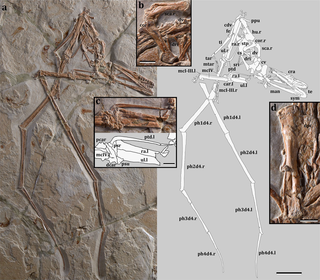
Mimodactylus is a genus of istiodactyliform pterosaur that lived in what is now Lebanon during the Late Cretaceous, 95 million years ago. The only known specimen was discovered in a limestone quarry near the town of Hjoula, belonging to the Sannine Formation. The owner of the quarry allowed the specimen to be prepared and scientifically described by an international team of researchers, and when it was eventually sold, the buyer donated it to the MIM Museum in Beirut. In 2019, the researchers named the new genus and species Mimodactylus libanensis; the generic name refers to the MIM Museum, combined with the Greek word daktylos for "digit", and the specific name refers to Lebanon. The well-preserved holotype specimen is the first complete pterosaur from the Afro-Arabian continent, and the third pterosaur fossil known from Lebanon.

Overoraptor is an extinct genus of paravian theropod of uncertain affinities from the Late Cretaceous Huincul Formation of Argentinian Patagonia. The genus contains a single species, O. chimentoi, known from several bones of the hands, feet, and hips alongside some vertebrae.

Caieiria is a genus of titanosaurian dinosaur from the Late Cretaceous Serra da Galga Formation of Brazil. The type and only species is Caieiria allocaudata.
The Hesseltal Formation or Blackcoloured Formation is a Late Cretaceous geological formation from northern Germany. It consists of lithified marls and limestone, with a unique series of black shales deposited in anoxic conditions during the Cenomanian-Turonian boundary event.
















